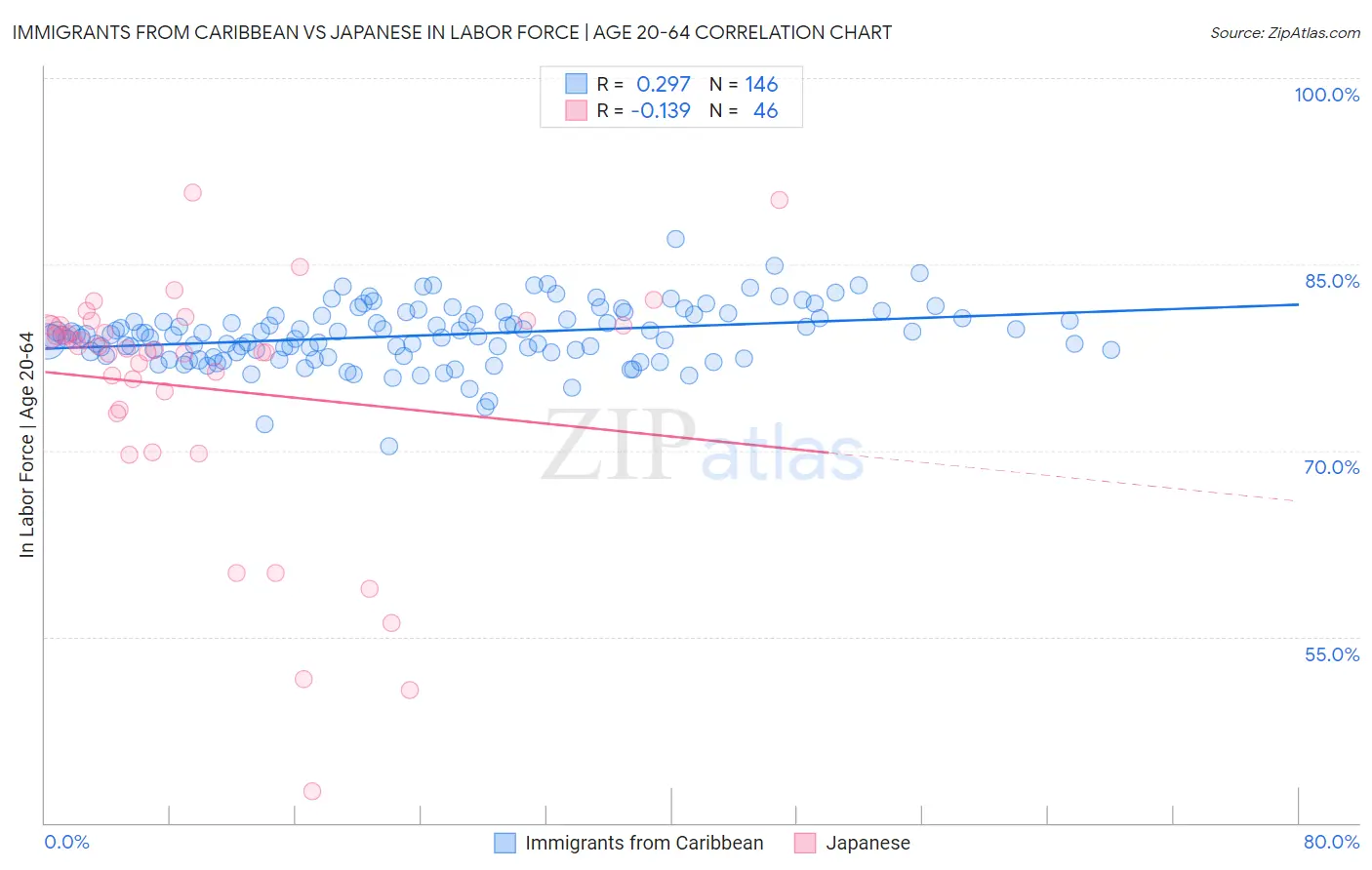Immigrants from Caribbean vs Japanese In Labor Force | Age 20-64
COMPARE
Immigrants from Caribbean
Japanese
In Labor Force | Age 20-64
In Labor Force | Age 20-64 Comparison
Immigrants from Caribbean
Japanese
78.8%
IN LABOR FORCE | AGE 20-64
1.0/ 100
METRIC RATING
248th/ 347
METRIC RANK
79.1%
IN LABOR FORCE | AGE 20-64
4.0/ 100
METRIC RATING
233rd/ 347
METRIC RANK
Immigrants from Caribbean vs Japanese In Labor Force | Age 20-64 Correlation Chart
The statistical analysis conducted on geographies consisting of 450,041,805 people shows a weak positive correlation between the proportion of Immigrants from Caribbean and labor force participation rate among population between the ages 20 and 64 in the United States with a correlation coefficient (R) of 0.297 and weighted average of 78.8%. Similarly, the statistical analysis conducted on geographies consisting of 249,187,220 people shows a poor negative correlation between the proportion of Japanese and labor force participation rate among population between the ages 20 and 64 in the United States with a correlation coefficient (R) of -0.139 and weighted average of 79.1%, a difference of 0.29%.

In Labor Force | Age 20-64 Correlation Summary
| Measurement | Immigrants from Caribbean | Japanese |
| Minimum | 70.3% | 42.6% |
| Maximum | 87.0% | 90.8% |
| Range | 16.7% | 48.2% |
| Mean | 79.3% | 75.0% |
| Median | 79.3% | 78.2% |
| Interquartile 25% (IQ1) | 77.9% | 73.3% |
| Interquartile 75% (IQ3) | 80.9% | 80.1% |
| Interquartile Range (IQR) | 3.0% | 6.8% |
| Standard Deviation (Sample) | 2.4% | 10.0% |
| Standard Deviation (Population) | 2.4% | 9.9% |
Demographics Similar to Immigrants from Caribbean and Japanese by In Labor Force | Age 20-64
In terms of in labor force | age 20-64, the demographic groups most similar to Immigrants from Caribbean are Immigrants from Germany (78.8%, a difference of 0.010%), Immigrants from Trinidad and Tobago (78.8%, a difference of 0.020%), English (78.8%, a difference of 0.030%), Honduran (78.8%, a difference of 0.030%), and Scottish (78.9%, a difference of 0.050%). Similarly, the demographic groups most similar to Japanese are Guamanian/Chamorro (79.1%, a difference of 0.030%), Immigrants from Canada (79.0%, a difference of 0.040%), Lebanese (79.1%, a difference of 0.050%), Tlingit-Haida (79.0%, a difference of 0.050%), and Samoan (79.0%, a difference of 0.060%).
| Demographics | Rating | Rank | In Labor Force | Age 20-64 |
| Native Hawaiians | 5.6 /100 | #230 | Tragic 79.1% |
| Lebanese | 5.1 /100 | #231 | Tragic 79.1% |
| Guamanians/Chamorros | 4.5 /100 | #232 | Tragic 79.1% |
| Japanese | 4.0 /100 | #233 | Tragic 79.1% |
| Immigrants | Canada | 3.2 /100 | #234 | Tragic 79.0% |
| Tlingit-Haida | 3.2 /100 | #235 | Tragic 79.0% |
| Samoans | 2.9 /100 | #236 | Tragic 79.0% |
| Immigrants | North America | 2.9 /100 | #237 | Tragic 79.0% |
| Immigrants | Jamaica | 2.6 /100 | #238 | Tragic 79.0% |
| Welsh | 2.4 /100 | #239 | Tragic 79.0% |
| Trinidadians and Tobagonians | 2.3 /100 | #240 | Tragic 79.0% |
| Jamaicans | 2.0 /100 | #241 | Tragic 78.9% |
| Immigrants | Micronesia | 1.9 /100 | #242 | Tragic 78.9% |
| Immigrants | West Indies | 1.7 /100 | #243 | Tragic 78.9% |
| French | 1.5 /100 | #244 | Tragic 78.9% |
| Scottish | 1.3 /100 | #245 | Tragic 78.9% |
| Immigrants | Trinidad and Tobago | 1.1 /100 | #246 | Tragic 78.8% |
| Immigrants | Germany | 1.0 /100 | #247 | Tragic 78.8% |
| Immigrants | Caribbean | 1.0 /100 | #248 | Tragic 78.8% |
| English | 0.9 /100 | #249 | Tragic 78.8% |
| Hondurans | 0.8 /100 | #250 | Tragic 78.8% |